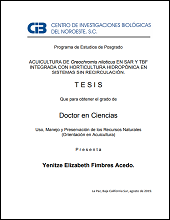Mostrar el registro sencillo del ítem
ACUICULTURA DE Oreochromis niloticus EN SAR Y TBF INTEGRADA CON HORTICULTURA HIDROPÓNICA EN SISTEMAS SIN RECIRCULACIÓN
Oreochromis niloticus IN RAS AND BFT INTEGRATING AQUACULTURE WITH HYDROPONICS HORTICULTURE IN NON-RECIRCULATED SYSTEM
| dc.contributor.advisor | MAGALLON BARAJAS, FRANCISCO JAVIER | |
| dc.contributor.advisor | SERVIN VILLEGAS, ROSALIA | |
| dc.contributor.author | FIMBRES ACEDO, YENITZE ELIZABETH | |
| dc.date.issued | 2019 | |
| dc.identifier | https://cibnor.repositorioinstitucional.mx/jspui/handle/1001/1644 | |
| dc.identifier.uri | http://dspace.cibnor.mx:8080/handle/123456789/2981 | |
| dc.description.abstract | "El crecimiento acelerado de la acuicultura ha permitido el desarrollo de distintos modelos de producción hiperintensiva, donde destacan los sistemas acuícolas de recirculación (SAR) y los sistemas de Tecnología de Biofloc (TBF). La búsqueda de sistemas que permitan producciones hiperintensivas sustentables ha llevado a la generación de sistemas integrados con horticultura hidropónica, sin embargo, la generación y liberación de residuales particulados constituye un reto actual. Con el propósito de integrar sistemas acuícolas de producción hiperintensiva, la presente investigación se divide en cuatro fases: I) cultivo hiperintensivo de tilapia Oreochromis niloticus en SAR, II) cultivo hiperintensivo de O. niloticus en TBF, III) caracterización de los residuales líquidos y particulados, su mineralización y solubilización, IV) incorporación de los residuales en cultivos de horticultura hidropónica mediante la Técnica de Flujo de Nutrientes (TFN). En los SAR se diseñó un modelo matemático para administrar la ingesta diaria de proteína (IDP), la cual se aplicó durante 34 semanas con tres tratamientos T1: 1.4, T2: 1.2 y T3: 1.0 con ajustes semanales mediante biometrías. Se caracterizó el flujo de nutrientes en la fracción líquida y sólida, la calidad de agua del cultivo, los parámetros de crecimiento y la composición nutricional de los organismos. El crecimiento final fue de 908 ± 57.9 g (T1), 887 ± 113.5 g (T2) y 702.2 ± 38.1 g (T3). La IDP moduló el crecimiento, el FCA, el contenido de lípidos y proteína en el cuerpo completo de los peces (p < 0.05), pero no en el contenido de los filetes. La IDP puede ser usada para proveer la proteína necesaria en cada etapa de crecimiento de O. niloticus, lo cual favorece la racionalización de alimento, el crecimiento de los organismos y modula el desperdicio y la generación de residuales. Para los sistemas TBF (fase II) se utilizaron 5 tratamientos con tres réplicas, en tres niveles tróficos (T1= quimioautotrófico, T2= heterotrófico, y fotoautotrófico (T3=Chlorella sorokiniana- 2805, T4= C. sorokiniana-2714, T5=C. spp) durante cuarenta semanas, con una IDP de 1.2. Se monitorearon los factores de crecimiento (biometrías semanales), la calidad del cultivo (NO2, NO3, PO4, NH4), se tomaron muestras de organismos (n 9) y de biofloc en el tiempo inicial, semana 10, 20, 30, 40 para análisis elementales, proximales y aminoácidos..." | es |
| dc.format | es | |
| dc.language.iso | eng | es |
| dc.language.iso | esp | |
| dc.publisher | Centro de Investigaciones Biológicas del Noroeste, S.C. | es |
| dc.rights | Acceso abierto | es |
| dc.subject | Oreochromis niloticus, Ingesta Diaria de Proteína, SAR, TBF, fase fotoautotrófica, hidroponía en TFN | es |
| dc.subject | Daily Protein Intake, RAS, BFT, photoautotrophic phase, hydroponics in NFT | es |
| dc.subject.classification | PISCICULTURA | es |
| dc.title | ACUICULTURA DE Oreochromis niloticus EN SAR Y TBF INTEGRADA CON HORTICULTURA HIDROPÓNICA EN SISTEMAS SIN RECIRCULACIÓN | es |
| dc.title | Oreochromis niloticus IN RAS AND BFT INTEGRATING AQUACULTURE WITH HYDROPONICS HORTICULTURE IN NON-RECIRCULATED SYSTEM | |
| dc.type | doctoralThesis | es |
| dc.dirtesis.grado | Doctorado en Ciencias en el Uso, Manejo y Preservación de los Recursos Naturales | es |
| dc.dirtesis.disciplina | Acuicultura | es |
| dc.dirtesis.universidad | Centro de Investigaciones Biológicas del Noroeste, S.C. | es |
| dc.dirtesis.facultad | Posgrado en Recursos Naturales | es |
| dc.description.abstracten | "The accelerated growth of aquaculture has enabled the development of different production models, including recirculation systems (RASs) and Biofloc Technology (BFT) systems. The search for systems that enable sustainable intensive production has led to the generation of integrated systems, however, the generation and release of particulate waste remains a challenge. In order to integrate hyper-intensive aquaculture production systems, this research is divided into four phases: I) cultivation of hyper-intensive Oreochromis niloticus tilapia in RAS, II) O. niloticus hyper-intensive cultivation in BFT, III) characterization of liquid and particulate residuals, particulate fraction mineralization, IV) incorporation of residuals into hydroponic horticulture crops in NFT. For RAS, a mathematical model was designed to administer daily protein intake (DPI), which was applied for 34 weeks with three treatments T1:1.4, T2: 1.2 and T3: 1. adjusted weekly using biometrics. The flow of nutrients in the liquid and solid fraction, the water quality of the crop, the growth parameters, the nutritional composition of the organisms were characterized. The final growth was 908 ± 57.9 g (T1), 887 ± 113.5 g (T2) and 702.2 ± 38.1 g (T3). The DPI conditioned the growth, the FCR, the amount of lipids and protein that contained the whole animal (p <0.05), but not the condition of the fillet. DPI can be used to provide the necessary protein at every stage of growth, favoring food rationalization, organism growth and avoiding waste and waste generation. For BFT (Phase II) 5 treatments with three replicates were used, implementing three trophic levels: T1=chemotrophic; T2=heterotrophic; and photoautotrophic (T3=Chlorella sorokiniana-2805, T4=C. sorokiniana-2714, T5=C. spp) for forty weeks. All growth factors (weekly biometrics), crop quality (NO2, NO3, PO4, NH4) are monitored. Organisms (n 9) and biofloc samples were taken at the initial time, week 10, 20, 30, 40 for elemental, proximal and amino acid analyses..." | es |


